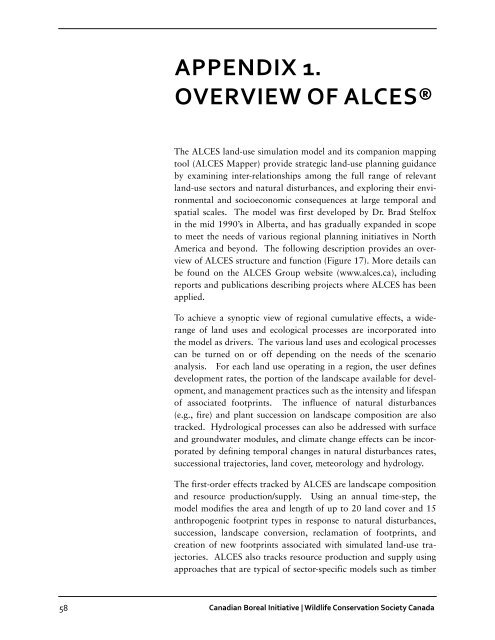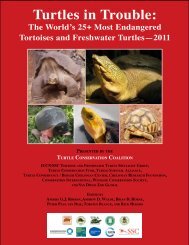Create successful ePaper yourself
Turn your PDF publications into a flip-book with our unique Google optimized e-Paper software.
Appendix 1.<br />
Overview of ALCES®<br />
The ALCES land-use simulation model and its companion mapping<br />
tool (ALCES Mapper) provide strategic land-use planning guidance<br />
by examining inter-relationships among the <strong>full</strong> range of relevant<br />
land-use sectors and natural disturbances, and exploring their environmental<br />
and socioeconomic consequences at large temporal and<br />
spatial scales. The model was first developed by Dr. Brad Stelfox<br />
in the mid 1990’s in Alberta, and has gradually expanded in scope<br />
to meet the needs of various regional planning initiatives in North<br />
America and beyond. The following description provides an overview<br />
of ALCES structure and function (Figure 17). More details can<br />
be found on the ALCES Group website (www.alces.ca), including<br />
<strong>report</strong>s and publications describing projects where ALCES has been<br />
applied.<br />
To achieve a synoptic view of regional cumulative effects, a widerange<br />
of land uses and ecological processes are incorporated into<br />
the model as drivers. The various land uses and ecological processes<br />
can be turned on or off depending on the needs of the scenario<br />
analysis. For each land use operating in a region, the user defines<br />
development rates, the portion of the landscape available for development,<br />
and management practices such as the intensity and lifespan<br />
of associated footprints. The influence of natural disturbances<br />
(e.g., fire) and plant succession on landscape composition are also<br />
tracked. Hydrological processes can also be addressed with surface<br />
and groundwater modules, and climate change effects can be incorporated<br />
by defining temporal changes in natural disturbances rates,<br />
successional trajectories, land cover, meteorology and hydrology.<br />
The first-order effects tracked by ALCES are landscape composition<br />
and resource production/supply. Using an annual time-step, the<br />
model modifies the area and length of up to 20 land cover and 15<br />
anthropogenic footprint types in response to natural disturbances,<br />
succession, landscape conversion, reclamation of footprints, and<br />
creation of new footprints associated with simulated land-use trajectories.<br />
ALCES also tracks resource production and supply using<br />
approaches that are typical of sector-specific models such as timber<br />
58 Canadian Boreal Initiative | Wildlife Conservation Society <strong>Canada</strong>







![RaLand / SeaScape [PDF] - Wildlife Conservation Society](https://img.yumpu.com/49974326/1/190x245/raland-seascape-pdf-wildlife-conservation-society.jpg?quality=85)









